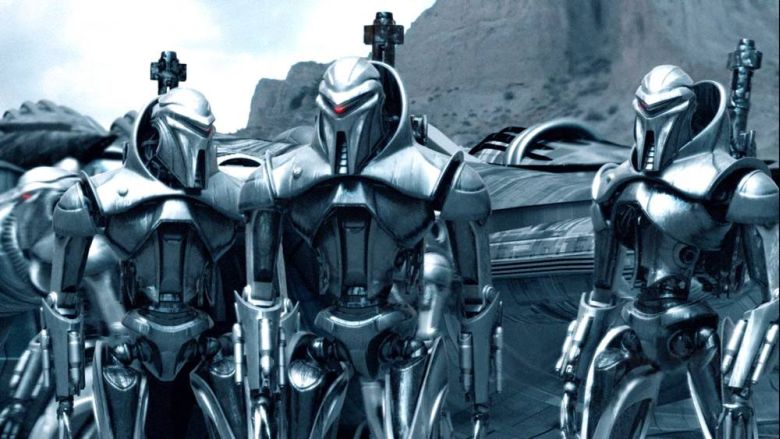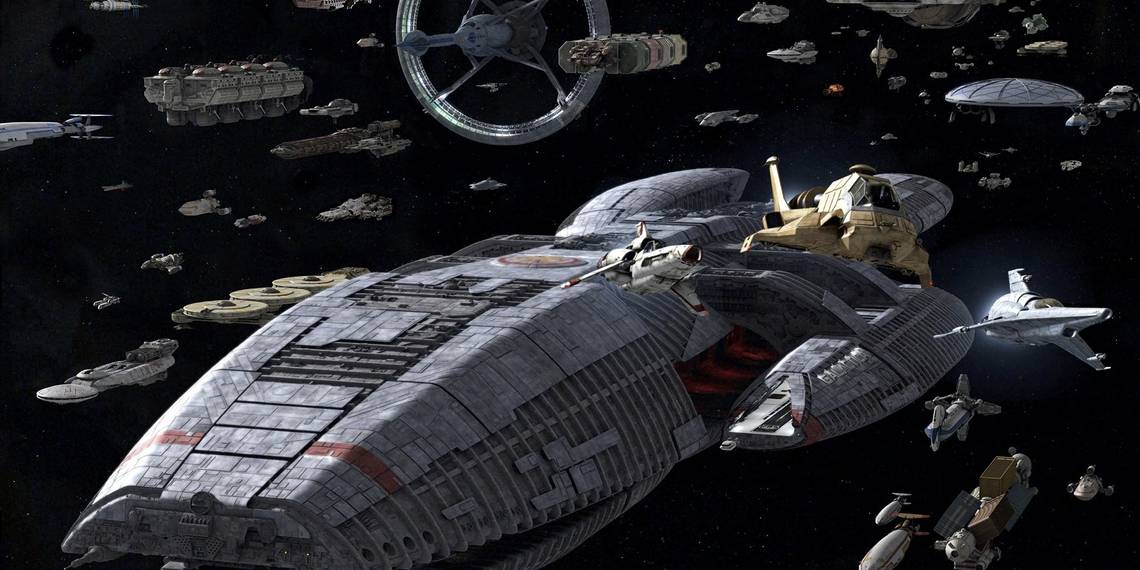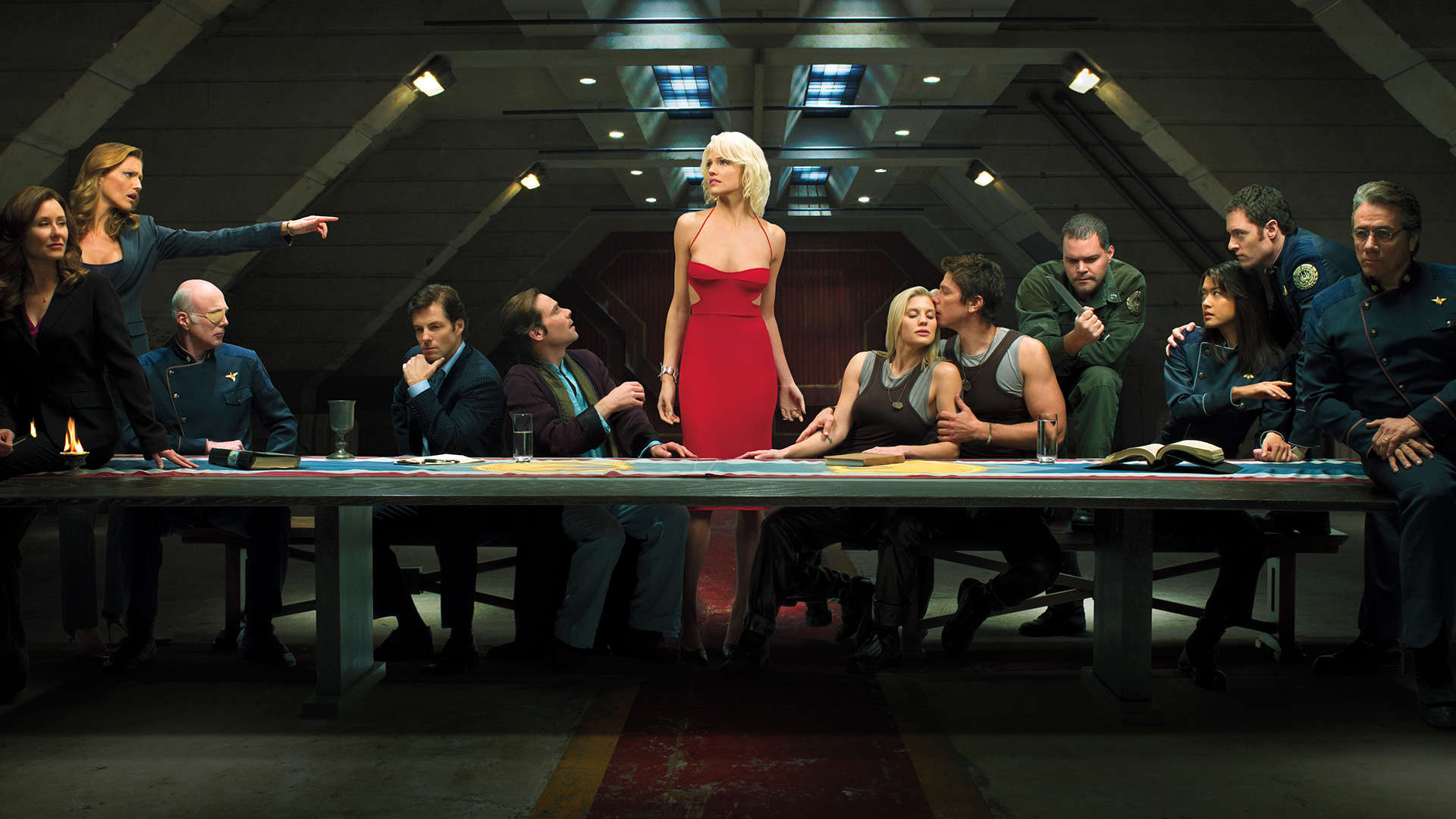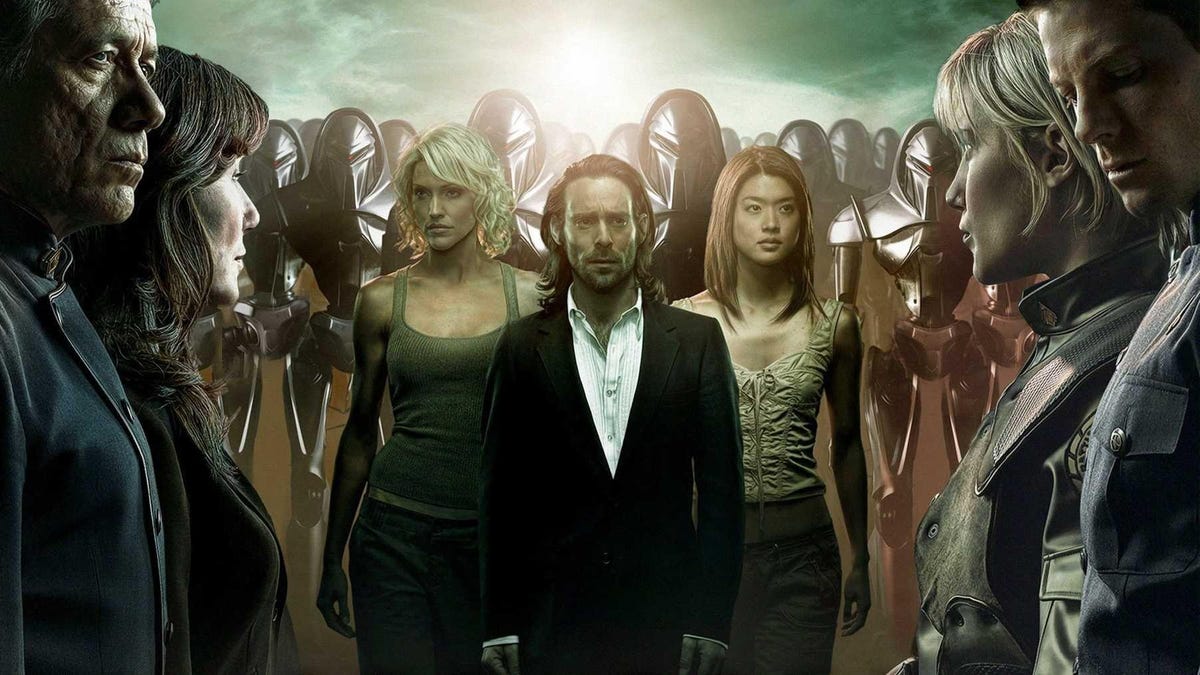Blog Review: Faith, Firepower, and Flaws: A Rewatch of Battlestar Galactica
“All of this has happened before, and all of it will happen again.” That phrase echoes through Battlestar Galactica like a prophecy, both spiritual and strategic. The reimagined 2004 series is a compelling hybrid of gritty military drama and deeply philosophical science fiction. But watching it today—after two decades of advances in space science, storytelling, and special effects—raises fascinating questions about where BSG soars, where it stumbles, and why it still matters.
Image Credit: Battlestar Galactica by SyFy (The Fleet)
The Military Edge: Order Amidst Chaos
At the heart of Battlestar Galactica lies a spacefaring military force holding a fragile line against extinction. The Galactica itself is a relic of an older war: analog systems, no networks, hardened against the very kind of cyberattack that obliterated its more modern counterparts. This setup gives the show a kind of World War II-in-space aesthetic: carrier ops, dogfights, chain of command, and tightly wound shipboard discipline.
The Viper pilots are some of the most iconic characters, but the show's portrayal of space fighter doctrine is... mixed. While visually exciting, the tactics often prioritize style over realism. Dogfighting in space, for example, tends to mimic Earth-like aerial combat rather than exploiting the physics of zero-G maneuvering. The "drifting and spinning" effects are a stylish nod to Newtonian physics, but actual squadron doctrine is often vague or counterproductive, especially during planetary assaults or defensive actions.
Command decisions, however, are more grounded. Commander Adama (Edward James Olmos) embodies military pragmatism, walking the razor’s edge between lawful authority and emotional intuition. His conflicts with President Roslin create one of the most nuanced depictions of civil-military relations in genre television. The show's strength is in these tense moments of leadership, compromise, and sacrifice, where the weight of decisions feels agonizingly real.
Image Credit: Battlestar Galactica by SyFy (The Cast)
The Theology of Survival
Where BSG truly sets itself apart is in its exploration of religion, not just as cultural dressing, but as a central thematic engine. The humans of the Twelve Colonies are polytheistic, worshipping gods with names and qualities drawn from Greco-Roman mythology. The Cylons, in stark contrast, are monotheistic. They believe in a singular, omnipotent God whose will guides their mission.
This inversion is brilliant. The artificial creations are the believers in divine purpose. The flawed, biological humans are fragmented in faith. This contrast drives much of the show's moral ambiguity. Are the Cylons zealots? Are the humans apostates? Or are both locked in a cosmic cycle of sin and retribution?
Characters like Gaius Baltar—scientist, narcissist, and eventual prophet—embody this tension. Baltar's arc is one of the strangest and most intriguing, as he’s dragged from cold rationalism into mystical visions and martyrdom. Whether he's delusional or divinely inspired is never made fully clear, and that ambiguity is the point.
Battlestar Galactica doesn’t answer religious questions so much as it demands the viewer ask them. Is suffering redemptive? Is forgiveness possible? Does humanity deserve survival? It’s a show about wandering in the wilderness, in every possible sense.

Image Credit: Battlestar Galactica by SyFy (Cylons)
Time, Science, and the Mythic Cycle
The science in BSG was never meant to be hard. The faster-than-light "jump drive" isn’t explained, nor does it need to be. It serves the narrative. But the show avoids technobabble for the most part, opting for a grittier, worn-out feeling to its tech. Ships feel industrial, not futuristic.
That said, some of the science and timeline details now feel clunky. The show's speculative cosmology—especially regarding Earth, Kobol, and the “cycle of time”—leans heavily on myth rather than astrophysical logic. The timeline is ultimately more poetic than precise, and fans expecting rigorous chronology or stellar cartography might be left unsatisfied.
CGI, too, is a mixed bag. The space battles have aged better than expected, especially with their use of handheld-style “cinematography” that mimics real war footage, but some shots of warp jumps and large-scale fleet maneuvers now look a bit dated compared to modern productions like The Expanse or Foundation.
But none of these flaws break the story. They exist alongside its strengths, as part of the era and ethos in which it was created. It’s worth noting: BSG aired before the “prestige sci-fi” era really took off. It was prestige sci-fi, ahead of its time.
Image Credit: Battlestar Galactica by SyFy
Legacy and Resonance
What makes Battlestar Galactica endure isn’t its tactical realism or scientific rigor. It’s the raw, emotional force behind its central question: What does it mean to be human in the face of annihilation?
In a post-9/11 world (and now, a post-pandemic, AI-haunted one), the series resonates more than ever. Themes of surveillance, religious extremism, identity, and moral compromise hit harder with each rewatch. The Cylons’ questions about their creators "Why did you make us?" echo in our own debates about artificial intelligence and the ethics of creation.
Yes, the fighter doctrine is inconsistent. The warp effects look vintage. The science drifts into mysticism. But the military and religious core of BSG remains a masterclass in speculative storytelling: a blend of fleet orders and sacred texts, of missiles and miracles.
So say we all.
Starbridge and the Legacy of Galactica
As Starbridge takes shape, it draws lasting inspiration from Battlestar Galactica. Not only for its dramatic storytelling and visual style, but for its grounded portrayal of military life: structured yet deeply human. The uniforms, chain of command, and quiet rituals aboard the Galactica echo into the tone and texture of Starbridge’s own war-torn future.
Military structure in BSG is meaningful without being over-explained. Rank carries real weight. Orders are not just delivered, they're questioned, lived with, and sometimes challenged. In Starbridge, this kind of tradition becomes the backbone of spacefaring service. Ships are led by captains shaped through years of duty. Enlisted crews form the moral center. Command decisions ripple beyond the bridge into personal bonds, family legacies, and private grief.
Most of all, Starbridge reflects the people behind the protocol. Pilots who live fast and love fiercely. Engineers who keep the systems running no matter the personal cost. Officers who shoulder responsibility they can’t always escape. The war isn't just fought with ships and firepower, but with memory, conviction, and the struggle to stay human.
The aesthetic is worn and real. Grit replaces gloss. Space is not just a battlefield, but a mirror. In this way, Starbridge carries forward the legacy of Battlestar Galactica, reimagining its influence for a new generation of stories and stars.




Comments
Post a Comment